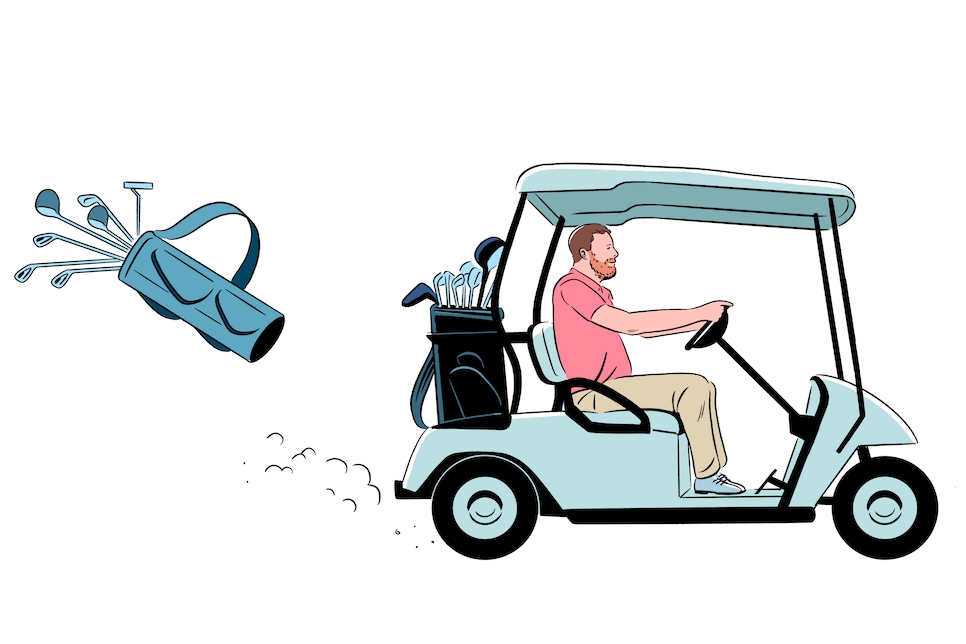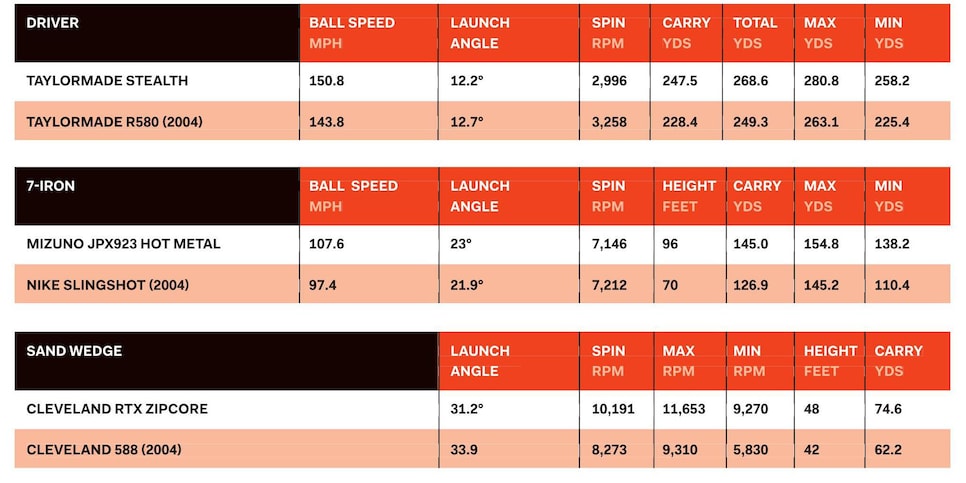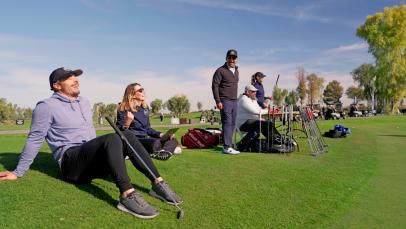Hope
Clash of the Eras: The clubs from our first Hot List 20 years ago face off against today’s equipment

Illustrations by Madison Ketcham
Despite covering the PGA Tour for a living, as far as equipment goes, I know less than your average weekend duffer. The clubs I’ve played for more than a decade are closer in age to the first Hot List than they are to this year’s. I’m bad enough that certain good clubs won’t help me. That’s why Golf Digest thought it would be interesting—or perhaps lurid—to have me compare clubs from the original 2004 Golf Digest Hot List with the crème de la crème of today.
The cast in this staged reality show would be:
Clubs from the original Golf Digest Hot List (2004): TaylorMade R580 driver, Callaway Steelhead III fairway woods, Nike CPR hybrid, Nike Slingshotirons, Cleveland 588 TourAction wedges, Odyssey 2-Ball putter
I HATED THE SLINGSHOT IRONS. THEY EVEN WHISTLED IN THE AIR AS IF WARNING ME TO STAY AWAY. HOLDING THEM FELT WRONG.
Today’s clubs: TaylorMade Stealth driver, Callaway Rogue ST LS fairway woods, Callaway Rogue ST Max OS 4-hybrid, Mizuno JPX923 Hot Metal irons, Cleveland RTX ZipCore wedges (54 and 60degrees), Odyssey Tri-Hot 5K Two putter
The old clubs arrived sporadically over two weeks, long cardboard boxes on my porch.I goofed around with the relics on the range a little bit, then decided to take them out for a serious nine holes on my home track, Hillandale Golf Course in Durham, N.C. It was rough.
I hated the Slingshot irons These might have been ahead of their time in 2004, but I found them atrocious. They even whistled in the air as if warning me to stay away, and something about holding them felt wrong, like hugging an alien. I don’t recall hitting a single good approach on those nine holes. I felt similarly about the Cleveland sand wedge, but this relationship was of the love-hate variety: For every duff ed shot, a bit of unexpected brilliance occurred, including a holeout from 30 yards for birdie.

However, the Nike hybrid was a revelation. This is embarrassing to admit, but I had never hit a hybrid before. I thought it was an old man’s club, but the few times I took out the CPR, the easy contact was sublime. From holding a slight disdain toward the idea of a hybrid, it took me about 12 minutes to start wondering if I should replace every iron in my bag.

SOFTWARE CAN RUN SIMULATIONS TO PREDICT HOW THE BALL WILL REACT. COMPARED TO TWO DECADES AGO, THE GUESSWORK IS GONE.
The R580 driver didn’t look like much, but it felt perfect in my hands. Though its distance was equivalent to the Rocketballz 3-wood I use, it was reliably arrow-straight. Standing over the ball, I felt the rare sensation of actually trusting where it would go.
The Odyssey 2-Ball putter brought a feeling not unlike human love. It came with an ungodly thick grip that the pro at my course mocked, but everything was going in or damn close. In my normal life, I use an old Scotty Cameron putter bent at the hosel to the extent that my stepfather gets mad at me for not replacing it.
Great driving and great putting kept me from disaster, but it was a mess in between. The final result was a 46. For what it’s worth, I’m turning 40 and have never broken 80 in my life despite having written down that goal years ago.
I have friends who have gone through the custom-fitting process, and they describe it like a Swedish massage—a salutary indulgence in which all is focused on you, and you don’t have to worry what your body or your game will look like in the harsh light of day. It sounded nice, but I’ve always been adept at dreading a good thing, and I was appropriately anxious heading into my fitting at Golf Galaxy. A fitting produces recommendations based on your swing; if my swing is an inconsistent mess, wouldn’t the recommendations be skewed?
Luckily, Devin Logue at Golf Galaxy was my port in the storm. Credit the man for his professionalism. I pretended the 2004 clubs were really mine, but whatever his thoughts on this mish-mashed ancient set—nostalgia, disgust, something worse—he kept his poker face. I had allotted an hour for the fitting, but I stayed for about four.
My first conclusion was that I wish I had a TrackMan bay. The feedback is incredible, and I don’t just mean distance. It tracks swing path, where you hit the ball on the face, spin rates— mine are embarrassingly high because of my nasty scoop—and how open or closed the clubface is at impact. It’s no coincidence that launch monitors are ubiquitous on the PGA Tour. Twenty years ago it wasn’t common for the best players in the world to be fit on a TrackMan. Today, it’s increasingly uncommon for bogey golfers to not get fit. I convinced myself that if I owned one, I’d be a scratch player by Valentine’s Day.
Shocker of all shockers, the new clubs were better. As much as I loved the R580, the new TaylorMade Stealth driver absolutely murders it in terms of distance. The best shot I hit with the R580 carried 237 yards and traveled 261; the best shot with the Stealth carried 256 yards and traveled 280. My clubhead speed with the Stealth was faster (103- 105 miles per hour compared to about 100), and so was my ball speed. The spin rate was lower, and though launch angle, smash factor and attack angle are all limited by my avowed mediocrity, everything looked better with the new stick.
The story was the same with the Callaway Rogue ST 3-wood against the Big Bertha Steelhead. Though I kept pulling the Big Bertha left, the Rogue ST had far more forgiveness. Not only was it rolling out to 250 yards, it was going straighter.
The most comical difference came between the Nike Slingshot irons and the Mizuno JPX923 Hot Metals. With the Nike 7-iron, my distance woes were depressing; three of the shots went 110 to 124 yards, with spin rates approaching and exceeding 8,000 revolutions per minute. With the Mizunos, I clustered three shots down the middle, 144, 145 and 146 yards. That’s when I realized the club was reliable enough to experiment, so I flattened my left wrist, focused on not scooping, and hit the next two 153 and 154 yards, closer to the distance I tell people I hit a 7-iron.
I WASN’T TRANSFORMED INTO A GREAT GOLFER, BUT TECHNOLOGY HAS INJECTED ME WITH THE HEADY, ELATING DRUG: HOPE.
With the 4-hybrid, the Nike CPR gave me left yank after left yank, but the Callaway was unerringly straight. It was the same with the wedges—the Cleveland RTX ZipCore 54-degree plotted out in tight little clusters, and the 588 sand wedge behaved like a drunken machine gunner.
By that point, I was embarrassingly sweaty from three-plus hours of swinging, and we concluded on the putting green. This struck me as the most inexact of all the measurements; lasers tracked the path of the club and impact angle, but a lot was judged in a short time based on the results of a few putts on a fast, straight surface with almost no warm-up. Devin found that my stroke was more reliable with a blade-style putter—sorry, 2-Ball mallet—and though I wanted to get the Toulon simply because it was more expensive and I’m superficial, Devin convinced me to go with the Tri-Hot 5K Two because it was generally more forgiving when I missed the sweet spot.
He upgraded me to some midsize grips to help relax the hands, added a half-inch of length to the iron shafts because apparently my arms are short for my 6-1 frame (this felt slightly emasculating) and reminded me to turn down the Stealth driver from 10.5 degrees to 9 degrees when I received it, which I still haven’t done.

I left the store convinced that the new clubs were far and away superior not just to the 2004 OG Hot List set but to my current decade-old clubs. What I didn’t know was why. For that, I reached out to Tom Mase, a recently retired professor of mechanical engineering at Cal-Poly and a former engineer at Callaway who also worked at Titleist-Cobra and is now a member of the Golf Digest technical panel.
I asked Mase about the 7-iron comparison in particular. What I didn’t realize is that lofts have changed, and though the old Nike 7-iron was 34 degrees, the Mizuno JPX923 was 28.5 degrees—even stronger than the Nike 6-iron. Thus, more distance would be expected. Remarkably, Mase explained, this increased distance comes with the flight behavior of the old 7-irons. On my shots, in fact, the landing angle (the steepness with which the ball hits the ground) was equal to or superior to the old clubs and with better spin rates and more height, and that’s the technological evolution. The manufacturers have figured out how to make a 28.5-degree loft behave like the 34-degree lofts of old in how the ball flies and lands, and by doing that, they’ve gifted players the extra distance.
How do they do it? The collective billions spent in research and development by the industry during the past 20 years makes a difference. Today, Mase says, computer-aided design has taken the game to the next level; rather than a human being drawing up an idea for a club, manufacturing a prototype and then testing it, modern software can experiment with multiple designs and run simulations to predict exactly how the ball will react when hit by the theoretical club. Before anyone touches a hunk of metal, the results are known, and the speed with which computer design and processing works means they can tweak until they get what they want on the simulation. Compared to two decades ago, the guesswork is gone.
The benefits are felt in many ways, spin being one. Advances in metal technology allow companies to create super thin faces that are more springy and comparable to old drivers in that quality. Modern drivers like the TaylorMade Stealth not only have high spring-like effect but a much bigger sweet spot and, crucially, a better “moment of inertia,” a measure of how much the club twists when you hit the ball off-center. Better perimeter weighting, a by-product of all the weight saved from thinner clubhead materials, means the club twists less, which produces better shots even with bad swings; yesterday’s duck hook is today’s mediocre-but-relatively-straight drive.
AND THE LAUNCH MONITOR SAYS . . .
TRACKMAN’S VERDICT SEEMS CLEAR: TODAY’S CLUBS PERFORM DECIDEDLY BETTER

All of this, Mase says, is changing at unprecedented rates. “Irons are not just a hunk of steel anymore,” he says. “There’s a lot of engineering there, and they’re on a crescendoing increase of technology.” Of course, lab work and theory is meaningless without a test in the wild, and that could only mean one thing: A John Henry-versus-the-machine-style duel on the course. I waited for my new clubs to arrive.
When my new clubs arrived, I went off to Hillandale again. I splurged on some new balls in the shop, and with both bags strapped to a cart and the entire back nine open, set out. For the gleaming new 2022 set, things started well. At the 400-yard 10th, a good drive down the left side of the fairway with the TaylorMade Stealth left me 155 to the green. I put the next shot pin high with a 7-iron, and though I three-putted like an idiot, it was a respectable bogey.
As for the oldies, the TaylorMade R580 driver sent the ball toward the pines, where it clipped a bough and landed on the wrong side of a mound of pine straw. (I will be describing the bad shots passively, as if the club did it and not me.) I hacked it twice just to get close to the fairway, from where a full swing with the Nike CPR hybrid produced a ground ball to third base, which led to a limp Nike Slingshot 7-iron, a bad chip, and a two-putt with the Odyssey 2-Ball. Quad to start, and one-up to technology and modernity.
This was not an anomaly but a harbinger. I’ll spare you the details, but at the second hole I made a double bogey with the new clubs and a quintuple-bogey 9 with the olds. If this were a military battle, the old clubs would have been fleeing for the woods. Maybe that’s a bit harsh; the R580 was responsible for two gorgeous drives, the 2-Ball was its usual competent self, and I even had a good chip with the Nike Slingshot 6-iron. But after shaking off the cobwebs, the new clubs shone, culminating on 18 when the Stealth produced a rocket with a slight draw, bending picturesquely around a big oak, settling between 270 and 280 yards. A moment later, the R580 that had served me so decently combusted, perhaps intimidated by the massive Stealth drive. It hooked one ball into the trees and then another.
The final score was 42 for the new clubs, 55 for the old, a 5-up victory for modernity in match play. I don’t recommend playing this way; it’s bizarre, probably not good for your swing, and annoying to take constant notes. Furthermore, poor grips, far more practice with the new clubs, and various other elements admittedly made the scientific value dubious.
All that said, I found the results edifying, and I imagined what it would be like to make the turn in both scenarios. With the old clubs, and the 55, it would be a story of frustration boiling into anger: That’s not me, but the numbers on the card would stare back with their cold truth.
Conversely, with a 42 in the back pocket, I’d be buoyant, knowing there was a possibility of something special. A friend suggested that this was a purely psychological phenomenon, that I played better with the new clubs because I believed they were better. Hogwash. Any fool can objectively see these tools are better, a chainsaw versus a dull stone, and though they didn’t transform me into a great golfer, technology has injected me with that heady, elating drug: hope.
I tossed the old clubs into my trunk, never to be played (by me) again. I made the turn with just the new set strapped to my cart. Technology be praised, a personal best was squarely in my sights.
I shot a 91.

